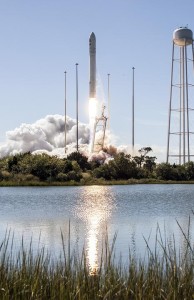
The Indian Space Research Organisation (ISRO) has said that it is postponing the launch of GSLV Mk-III to March-April this year.
GSLV Mk-III is ISRO’s heaviest rocket and its launch was tentatively scheduled for January 20. The rocket was to put 3.2 tonne GSAT-19 satellite in orbit.
According to Deccan Chronicle, the launch has been postponed as ISRO is yet to complete some tests on the vehicle.
“Some more tests are planned for the vehicle and the stage level tests also got delayed,” said K Sivan, director, Vikram Sarabhai Space Centre (VSSC), Thiruvananthapuram, while talking to Deccan Chronicle.
“Now, these tests will be conducted this month. If any issues arise during the tests we will correct them.”
In last December, ISRO had successfully conducted the high altitude test for large cryogenic engine CE-20 that is being used in GSLV Mk-III.
ISRO also has plans to launch the SAARC satellite using GSLV Mk-II rocket in March-April this year.
“We are planning to launch both the GSLV Mk-III and GSLV Mk-II rockets in March and April. Maybe one will be launched in March and another one in April depending on the availability of the launch pad,” K Sivan added.
ISRO is also doing final preparations for next month launch of record number of 103 satellites using its PSLV rocket.
“The PSLV-C37 rocket will launch 103 micro-small satellites during the second week of February,” K Sivan said.
So far, Russia holds the record for launching the highest number of 37 satellites in a single mission. This record was set in 2014. Interestingly, the maximum number of satellites launched by NASA in a single mission is 29.
ISRO grabbed the attention of the whole world by creating lunar orbiter Chandrayaan-1and Mars Orbiter Mission (MOS). Chandrayaan-1 was sent to moon on 22 October 2008. MOS also got success in entering the Mars orbit on 24 September 2014, thus making India the world’s first nation to succeed on its first attempt. India also became the first space agency in Asia and fourth in the world to have successfully reached Mars orbit.
In May 2016, India successfully launched its first-ever indigenous space shuttle – the Re-Usable Launch Vehicle – Technology Demonstrator (RLV-TD) from Sriharikota in Andhra Pradesh.
RLV-TD, the country’s first winged-body aerospace vehicle, is being said to be the ISRO’s first step towards developing a reusable launch vehicle that would be capable of sending spacecraft into orbit and then returning to the Earth. After this technology is developed completely, it would be possible to launch spacecraft, including satellites, into space and make them re-enter earth’s atmosphere. During re-entry, the spacecraft would withstand extreme pressure and heat conditions, and then land in at an intended spot. The technology would substantially reduce costs of launch of space vehicles.
ISRO is currently working on several other projects, including development of GSLV Mk III, ULV, reusable launch vehicle, human spaceflight, interplanetary probes, solar spacecraft mission, etc.